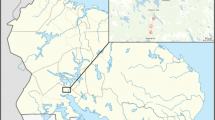Abstract
The populations ofKlebsieila pneumoniae, Escherichia coli, Enterobacter aerogenes, andPseudomonas sp. fell following their addition to soil, but species lysing these gram-negative bacteria were not detected. The numbers ofStaphylococcus aureus andMicrococcus flavus fell by more than four orders of magnitude and ofSaccharomyces cerevisiae by more than two orders after their addition to soil. Organisms lysing these gram-positive bacteria were present in soil, but their numbers did not increase as a result of the additions. Lytic activity againstS. aureus was detected in soil filtrates, but this activity was not enhanced by inoculation of soil with the bacterium. Addition of cycloheximide to soil suspensions delayed the fall in abundance ofM. flavus but did not suppress the lytic populations. We conclude that lysis is not responsible for the decline of bacteria orS. cerevisiae added to soil.
Similar content being viewed by others
References
Alexander M (1981) Why microbial predators and parasites do not eliminate their prey and hosts. Annu Rev Microbiol 35:113–133
Bagnyuk VM, Zakordonets OA (1980) Investigation of the ecological role of lytic bacteria in activated sludge (in Russian). Dokl Akad Nauk SSSR, Biol Sci 254:1018–1021
Bloomfield BJ, Alexander M (1967) Melanins and resistance of fungi to lysis. J Bacteriol 93:1276–1280
Drozanski W (1969) Bacteriolytic spectrum of the enzyme produced byAcanthamoeba castellanii. Acta Microbiol Polon Ser A 1:169–174
Gillespie DC, Cook FD (1965) Extracellular enzymes from strains ofSorangium. Can J Microbiol 11:109–118
Gunnison D, Alexander M (1975) Basis for the susceptibility of several algae to microbial decomposition. Can J Microbiol 21:619–628
Habte M, Alexander M (1977) Further evidence for the regulation of bacterial populations in soil by protozoa. Arch Microbiol 113:181–183
Hagedorn C, Hansen DT, Simonson GH (1978) Survival and movement of fecal indicator bacteria in soil under conditions of saturated flow. J Environ Qual 7:55–59
Hirte WF (1977) Zur Lebensfähigkeit und Überlebensfähigkeit allochthoner und autochthoner Bakterien in Boden nach einer Superinfektion. Zentralbl Bakteriol Abt II 132:434–451
Jones D, Webley DM (1967) Lysis of the cell walls of yeast (Saccharomyces cerevisiae) by soil fungi. Trans Brit Mycol Soc 50:149–154
Kitamura K, Kaneko T, Yamamoto Y (1972) Lysis of viable yeast cells by enzymes ofArthrobacter luteus. Isolation of lytic strain and study of its lytic activity. J Gen Appl Microbiol 18:57–71
Kletter B, Henis Y (1963) Comparative studies on the growth of myxobacteria on bacterial suspensions. Can J Microbiol 9:577–584
Liang LN, Sinclair JL, Mallory LM, Alexander M (1982) Fate in model ecosystems of microbial species of potential use in genetic engineering. Appl Environ Microbiol 44:708–714
Lloyd AB, Lockwood JL (1966) Lysis of fungal hyphae in soil and its possible relation to autolysis. Phytopathology 56:595–602
Mallory LM, Yuk CS, Liang LN, Alexander M (1983) Alternative prey: a mechanism for elimination of bacterial species by protozoa. Appl Environ Microbiol 46:1073–1079
Mitchell R, Yankofsky S, Jannasch HW (1967) Lysis ofEscherichia coli by marine microorganisms. Nature (London) 215:891–893
Pengra RM, Cole MA, Alexander M (1969) Cell walls and lysis ofMortierella parvispora hyphae. J Bacteriol 97:1056–1061
Salton MRJ (1955) Isolation ofStreptomyces spp. capable of decomposing preparations of cell walls from various micro-organisms and a comparison of their lytic activities with those of certain actinomycetes and myxobacteria. J Gen Microbiol 12:25–30
Sinclair JM, Alexander M (1984) Role of resistance to starvation in bacterial survival in sewage and lake water. Appl Environ Microbiol 48:410–415
Author information
Authors and Affiliations
Rights and permissions
About this article
Cite this article
Tang, Y.J., Alexander, M. Absence of a role for lytic microorganisms in the decline of bacteria andSaccharomyces introduced into soil. Microb Ecol 14, 67–73 (1987). https://doi.org/10.1007/BF02011571
Issue Date:
DOI: https://doi.org/10.1007/BF02011571




